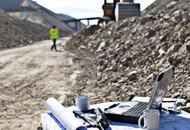Semi-Rugged vs. Fully Rugged Laptops: Which One Suits Your Needs?
Posted by Bob Johnson on 10th Nov 2023
Harsh conditions are par for the course in rugged industries like construction, military operations, and law enforcement - and that’s where standard laptops often fall short.
The call for ruggedness highlights the benefits of both semi-rugged and fully rugged computing solutions. Each category offers a unique set of features and capabilities, tailor-made to meet specific needs.
Let’s look at some prominent fully rugged Panasonic and semi-rugged Dell models to help you decide which is best for your team. We’ll compare the general differences between semi-rugged and fully rugged laptops while we’re at it.
When To Purchase Fully Rugged Laptops
Is your typical work day spent on a construction site during a downpour, on a military mission in the desert, or on an offshore drilling platform? Fully rugged laptops are your reliable partners in such instances without downtime. They’re designed to keep your operations running at full capacity.
If your fieldwork team experiences frequent equipment failures, data loss, or productivity slowdowns, a fully rugged upgrade could be a game-changer.
When To Purchase Semi-Rugged Laptops
For professionals who split their time between the office and field, semi-rugged laptops strike the perfect balance. Think of an insurance adjuster on-site or a field service technician. Semi-rugged devices offer durability without the bulk, making them ideal for less extreme environments requiring flexibility and reliability.
Semi-rugged investments may be more cost-effective in the long run if your basic laptops struggle with basic tasks. They can boost your productivity while providing peace of mind against minor spills, dust, or accidental bumps.

Pros & Cons of Semi-Rugged and Fully Rugged Laptops
The differences between semi-rugged and fully rugged laptops basically lie in how reliable they are in your work settings. Here’s a head-to-head comparison of their pros and cons to help you decide better.
Pros of a Fully Rugged laptop
Fully rugged laptops are the gold standard in rugged computers. From military operations to mining and emergency services, they’re well-suited to the most challenging work settings. They’re custom-built and military-grade, so you can leave them out in the rain all night and drop from over three feet without a hitch.
These models have high IP ratings and MIL-STD certifications. Panasonic Toughbook CF-31, for instance, has MIL-STD-810G; CF-33 has MIL-STD-810F; CF-31 has MIL-STD-810H. These attest to their superior durability and resilience in extreme temperatures, outperforming semi-rugged alternatives.
Bonus: The CF-33 has dual battery slots for long battery life during extended working hours. It also features a detachable backlit chiclet keyboard, while rugged tablets like the FZ-G1 work with an attachable iKey keyboard.
Panasonic sets the bar high for fully rugged devices. They come with sealed internals, magnesium alloy chassis, and reinforced components that surpassed military standards. For added security, they have removable disk drives or solid-state drives (SSDs).
Cons of a Fully Rugged laptop
If portability is non-negotiable, fully rugged models aren’t your best choice. They’re often heavier and bulkier than commercial and semi-rugged laptops. The latter can weigh around 2 to 5 pounds, while a fully rugged one can tip the scales at 6 to 8 pounds (sometimes even 10 pounds).
Fully rugged laptops also come with a premium price tag. They can cost several times more than other models with similar specifications. This can be a considerable investment for businesses with several onsite staff.
Pros of a Semi-Rugged laptop
Semi-rugged laptops are engineered to bridge the gap between regular laptops and their fully-rugged counterparts. They’re purpose-built to tackle the challenges of slightly harsh environments like construction sites and field operations while offering mobility.
Take the semi-rugged Dell Latitude 5414/5424 and Toughbook CF-54/CF-55. They offer respectable protection against dust and water than your average store-bought computers. Latitude 5414 and 5424 feature steady handles with sturdy rubber grips, while Toughbook CF-54 and CF-55 have retractable handles for extra portability.
These devices undergo specific stress testing and certifications to meet military standards for certain internal components. But above all, they maintain a more budget-friendly price point compared to fully rugged laptops.
Cons of a Semi-Rugged laptop
The semi-rugged construction can keep light dust and moisture out. However, it lacks the resilience to endure severe drops and impacts (limited to one-meter drops onto concrete, to be precise). They also often fall short in terms of screen visibility in sun-exposed locations.
Some older semi-rugged models max out at 16GB of RAM while newer models max out at 32GB of RAM. That means a more extensive search and evaluation process to find the best fit for your performance and multitasking demands.
Semi-Rugged vs Fully Rugged Laptops: Shop Smart At Bob Johnson’s
So, we’ve made it clear: opting for a semi-rugged or fully rugged laptop depends on your priorities. But if you’re still unsure what to get, contact our team today for expert guidance. We’ll help you find the perfect rugged solution tailored to your needs.
To get started, browse our inventory of fully rugged Panasonic Toughbooks here.

